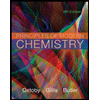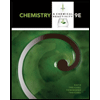
Laboratory Experiments for Chemistry: The Central Science (13th Edition)
13th Edition
ISBN: 9780321949912
Author: Theodore E. Brown, John H. Nelson, Kenneth C. Kemp
Publisher: PEARSON
expand_more
expand_more
format_list_bulleted
Concept explainers
Textbook Question
Chapter 6, Problem 6E
The familiar phenomenon of a rainbow results from the diffraction of sunlight through raindrops. (a) Does the
(c) Suppose that instead of sunlight, the visible light from a hydrogen discharge tube (Figure 6.10) was used as the lightsource. What do you think the resulting "hydrogen discharge rainbow" would look like? [Section 6.3]

Expert Solution & Answer
Want to see the full answer?
Check out a sample textbook solution
Students have asked these similar questions
The photolysis of H3C–N=N–C2H5 involves the breaking of the single bonds shown. According to this, in addition to N2, what products would be obtained primarily if the reaction were carried out in the gas phase or in solution in an inert solvent?
Given a keto-enol tautomerization reaction, which is greatly influenced by the type of solvent, indicate which of the following solvent properties cannot be considered a "solvent effect"?(A) Dielectric constant(B) Polarity(C) Hydrogen bonding capacity(D) Temperature
In solution reactions, what does "solvent effect" mean?
Chapter 6 Solutions
Laboratory Experiments for Chemistry: The Central Science (13th Edition)
Ch. 6.1 - Prob. 6.1.1PECh. 6.1 - Practice Exercise 2 If one of the waves in the...Ch. 6.1 - Prob. 6.2.1PECh. 6.1 - Prob. 6.2.2PECh. 6.2 - Assuming standard conditions, arrange the...Ch. 6.2 - Prob. 6.3.2PECh. 6.3 - Practice Exercise 1 In the top part of Figure...Ch. 6.3 - Prob. 6.4.2PECh. 6.4 - Prob. 6.5.1PECh. 6.4 - For each of the following reactions, write a...
Ch. 6.5 - Prob. 6.6.1PECh. 6.5 - Prob. 6.6.2PECh. 6.8 - Prob. 6.7.1PECh. 6.8 - Prob. 6.7.2PECh. 6.9 - A cell has a standard cell potential of +0.177 V...Ch. 6.9 - Prob. 6.8.2PECh. 6.9 - Prob. 6.9.1PECh. 6.9 - Prob. 6.9.2PECh. 6 - Prob. 1DECh. 6 - Prob. 1ECh. 6 - Prob. 2ECh. 6 - Prob. 3ECh. 6 - Prob. 4ECh. 6 - Prob. 5ECh. 6 - The familiar phenomenon of a rainbow results from...Ch. 6 - Prob. 7ECh. 6 - Prob. 8ECh. 6 - Prob. 9ECh. 6 - Prob. 10ECh. 6 - Prob. 11ECh. 6 - Prob. 12ECh. 6 - Prob. 13ECh. 6 - Prob. 14ECh. 6 - Prob. 15ECh. 6 - In some applications nickel-cadmium batteries have...Ch. 6 - Prob. 17ECh. 6 - Prob. 18ECh. 6 - Prob. 19ECh. 6 - Prob. 20ECh. 6 - Prob. 21ECh. 6 - Prob. 22ECh. 6 - Prob. 23ECh. 6 - Prob. 24ECh. 6 - Prob. 25ECh. 6 - Prob. 26ECh. 6 - Prob. 27ECh. 6 - Metallic magnesium can be made by the electrolysis...Ch. 6 - 20.93
Calculate the mass of Li formed by...Ch. 6 - Prob. 30ECh. 6 - Prob. 31ECh. 6 - Prob. 32ECh. 6 - Prob. 33ECh. 6 - Titanium metal requires a photon with a minimum...Ch. 6 - Explain how the existence of line spectra is...Ch. 6 - Prob. 36ECh. 6 - Prob. 37ECh. 6 - Prob. 38ECh. 6 - Prob. 39ECh. 6 - Prob. 40ECh. 6 - Prob. 41ECh. 6 - Prob. 42ECh. 6 - Prob. 43ECh. 6 - Prob. 44ECh. 6 - Prob. 45ECh. 6 - Prob. 46ECh. 6 - Prob. 47ECh. 6 - Prob. 48ECh. 6 - Prob. 49ECh. 6 - Prob. 50ECh. 6 - Prob. 51ECh. 6 - Prob. 52ECh. 6 - Prob. 53ECh. 6 - Prob. 54ECh. 6 - Prob. 55ECh. 6 - Prob. 56ECh. 6 - Prob. 57ECh. 6 - Prob. 58ECh. 6 - Prob. 59ECh. 6 - Prob. 60ECh. 6 - Prob. 61ECh. 6 - Prob. 62ECh. 6 - Prob. 63ECh. 6 - Prob. 64ECh. 6 - Prob. 65ECh. 6 - Prob. 66ECh. 6 - Prob. 67ECh. 6 - Prob. 68ECh. 6 - Prob. 69ECh. 6 - Prob. 70ECh. 6 - Prob. 71ECh. 6 - Prob. 72ECh. 6 - Prob. 73ECh. 6 - Prob. 74ECh. 6 - Prob. 75ECh. 6 - Prob. 76ECh. 6 - Prob. 77ECh. 6 - Prob. 78ECh. 6 - Prob. 79ECh. 6 - Prob. 80ECh. 6 - Prob. 81AECh. 6 - Prob. 82AECh. 6 - Prob. 83AECh. 6 - In August 2011, the Juno spacecraft Was launched...Ch. 6 - Prob. 85AECh. 6 - Prob. 86AECh. 6 - Prob. 87AECh. 6 - Prob. 88AECh. 6 - Prob. 89AECh. 6 - Prob. 90AECh. 6 - Prob. 91AECh. 6 - Prob. 92AECh. 6 - Prob. 93AECh. 6 - Prob. 94AECh. 6 - Prob. 95AECh. 6 - Prob. 96AECh. 6 - Prob. 97AECh. 6 - Prob. 98AECh. 6 - Prob. 99AECh. 6 - Prob. 100AECh. 6 - Prob. 101AECh. 6 - Prob. 102AECh. 6 - A voltaic cell utilizes the following reaction:...Ch. 6 - Prob. 104AECh. 6 - Prob. 105IECh. 6 - Prob. 106IECh. 6 - Prob. 107IECh. 6 - Prob. 108IECh. 6 - Prob. 109IECh. 6 - 20. 72 A voltaic cell is constructed that is based...
Knowledge Booster
Learn more about
Need a deep-dive on the concept behind this application? Look no further. Learn more about this topic, chemistry and related others by exploring similar questions and additional content below.Similar questions
- How to solvearrow_forwardIndicate the concentration and ionic strength ranges to which the Debye-Huckel equation can be applied. And the Davies equation?arrow_forwardIf the ionic strength (I) of a solution is very low, the Debye-Huckel equation is used. If I is higher, the Davies equation is used. What is the correct value for I to use one or the other?arrow_forward
- In both the Debye-Huckel equation and the Davies equation, there is a constant A. I see that sometimes it appears as 0.51 and other times as 1.02. Explain why one or the other value is used.arrow_forwardThe two equations are forms of the Davies equation, used in thermodynamics for activity coefficients: ال log Y₁ = -Az² - 0,31 log = Az² - 0,31 1 + √Ĩ 1 + √√ k These equations are consistent and imply that Yi = Is this last equation correct? karrow_forwardThe two equations are forms of the Davies equation, used in thermodynamics for activity coefficients: ال log Y₁ = -Az² - 0,31 log = Az² - 0,31 1 + √Ĩ 1 + √√ k These equations are consistent and imply that Yi = Is this last equation correct? karrow_forward
- For the Davies equation, both expressions are correct: log Y₁ = -Az² √i - 0,31 1 + √ k log- = Az - 0,31 k 1 + √Ĩarrow_forwardk In Davies' equation log y₁ = log- log y₁ = log | = -Az² + ✓// k A is a constant that always equals 1.02. Correct? - 0,31arrow_forwardIndicate whether the equality is true Yi How is it obtained? k%arrow_forward
- Indicate the relationship between the activity coefficient YA and the rate constant of a bimolecular reaction in solution k and the rate constant at infinite dilution ko.arrow_forwardDescribe the saline effect that occurs in solutions.arrow_forwardBriefly explain what the infinite dilution rate constant (k∞) consists of.arrow_forward
arrow_back_ios
SEE MORE QUESTIONS
arrow_forward_ios
Recommended textbooks for you
 ChemistryChemistryISBN:9781305957404Author:Steven S. Zumdahl, Susan A. Zumdahl, Donald J. DeCostePublisher:Cengage Learning
ChemistryChemistryISBN:9781305957404Author:Steven S. Zumdahl, Susan A. Zumdahl, Donald J. DeCostePublisher:Cengage Learning Chemistry: An Atoms First ApproachChemistryISBN:9781305079243Author:Steven S. Zumdahl, Susan A. ZumdahlPublisher:Cengage Learning
Chemistry: An Atoms First ApproachChemistryISBN:9781305079243Author:Steven S. Zumdahl, Susan A. ZumdahlPublisher:Cengage Learning
 Principles of Modern ChemistryChemistryISBN:9781305079113Author:David W. Oxtoby, H. Pat Gillis, Laurie J. ButlerPublisher:Cengage Learning
Principles of Modern ChemistryChemistryISBN:9781305079113Author:David W. Oxtoby, H. Pat Gillis, Laurie J. ButlerPublisher:Cengage Learning Chemistry & Chemical ReactivityChemistryISBN:9781133949640Author:John C. Kotz, Paul M. Treichel, John Townsend, David TreichelPublisher:Cengage Learning
Chemistry & Chemical ReactivityChemistryISBN:9781133949640Author:John C. Kotz, Paul M. Treichel, John Townsend, David TreichelPublisher:Cengage Learning Chemistry & Chemical ReactivityChemistryISBN:9781337399074Author:John C. Kotz, Paul M. Treichel, John Townsend, David TreichelPublisher:Cengage Learning
Chemistry & Chemical ReactivityChemistryISBN:9781337399074Author:John C. Kotz, Paul M. Treichel, John Townsend, David TreichelPublisher:Cengage Learning

Chemistry
Chemistry
ISBN:9781305957404
Author:Steven S. Zumdahl, Susan A. Zumdahl, Donald J. DeCoste
Publisher:Cengage Learning

Chemistry: An Atoms First Approach
Chemistry
ISBN:9781305079243
Author:Steven S. Zumdahl, Susan A. Zumdahl
Publisher:Cengage Learning


Principles of Modern Chemistry
Chemistry
ISBN:9781305079113
Author:David W. Oxtoby, H. Pat Gillis, Laurie J. Butler
Publisher:Cengage Learning

Chemistry & Chemical Reactivity
Chemistry
ISBN:9781133949640
Author:John C. Kotz, Paul M. Treichel, John Townsend, David Treichel
Publisher:Cengage Learning

Chemistry & Chemical Reactivity
Chemistry
ISBN:9781337399074
Author:John C. Kotz, Paul M. Treichel, John Townsend, David Treichel
Publisher:Cengage Learning
Quantum Mechanics - Part 1: Crash Course Physics #43; Author: CrashCourse;https://www.youtube.com/watch?v=7kb1VT0J3DE;License: Standard YouTube License, CC-BY